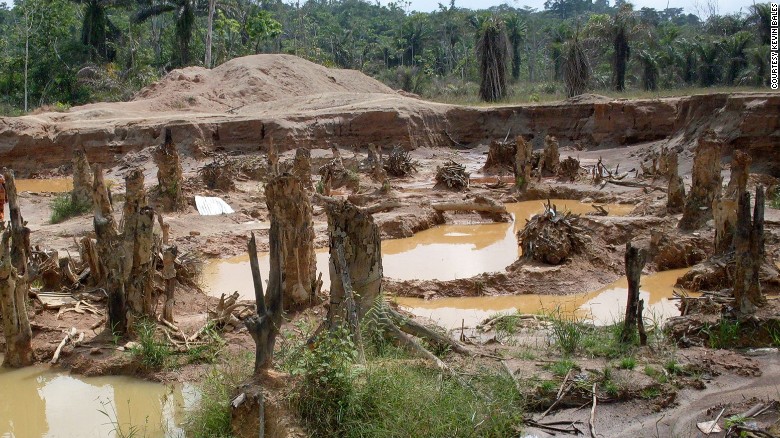How Modern Slavery Is Destroying the Environment
ENVIRONMENT, 6 Jun 2016
- Modern slavery is driving huge deforestation.
- Criminals make slaves cut forests to support commodities such as gold, minerals for cell phones and laptops, and shrimp and fish.
- Slavery is a major contributor to climate change.
31 May 2016 – It’s all about the trees.
We all know that transportation contributes to climate change. Cars, buses, airplanes, all the different ways we move around powered by fossil fuels, push CO2 into the air.
Anything we can do to reduce those emissions is good, but what we often fail to realize is that transportation accounts for just 14% of CO2 emissions, while other sources not only account for more, they are also easier to reduce. One of the most important of these is the deforestation that contributes 17% of all CO2 emissions — and that is where slavery comes in.
To write my new book “Blood and Earth,” I traveled around the world for seven years looking closely at the links between slavery and environmental destruction. I started this research after more than 15 years working and writing on modern slavery. Doing that work I met people in slavery and slaveholders, and witnessed slavery in action. What struck me over and over was how almost everywhere I saw slaves they were being forced to devastate the environment around them.
Digging deeply into this link between slavery and ecological destruction I uncovered a vicious cycle driven by our consumption patterns and supported by well-meaning environmental treaties and regulations.
For the last 20 years, the amount of land and forests especially set aside as reserves and protected spaces has significantly increased. In the developing world this has meant a decrease in legal logging, but a dramatic increase in illegal smash and grab cutting.
Put simply, criminals rushed into the vacuum created by new environmental treaties. Not caring about people or nature, they destroyed both in the process. Sometimes this attack was aimed at cutting and selling timber, but more often it is in support of lucrative slave-based commodities such as gold, minerals for cell phones, laptops, shrimp, or fish.
With the profits flowing back down the supply chain from our purchases of phones, computers, jewelry, and food for both our pets and ourselves, slave-using criminals make big profits from ripping up the Earth’s forests.
Environmental Destruction
A good example is the Sundarbans UNESCO World Heritage Site covering 4,000 square miles (10,000 square kilometers) of mangrove forest at the bottom of Bangladesh and India.
Protected since the late 1970s, this is the largest carbon sink in Asia, one of the largest mangrove forests in the world, and the special refuge and breeding grounds of the Bengal Tiger and many other endangered species.
Here slaveholders cut the forest and install fish processing camps using child slaves, or clear and excavate the land to put in shrimp farms. The result is coastal villages, once protected by the mangrove forests are now inundated when cyclones hit, causing widespread deaths and ruining the land for future farming. Meanwhile, pushed from their territories, Bengal tigers prey on the only small mammals left — the child slaves.
In Ghana criminals force slaves to dig for gold in protected forests, and in doing so saturate the ecosystem with mercury, a poison and pollutant so potent that the land, plants, insects, animals and people living there will be affected for decades to come.
The gold produced through slave labor flows into the global market and can end up in our wedding rings, jewelry and electronics. In Eastern Congo, armed gangs enslave whole villages to dig coltan and cassiterite for our computers and phones, or to cut and burn the Virunga Forest, Africa’s oldest protected park and home of the mountain gorillas, to sell as charcoal.
The Cost of Slavery
Altogether, the environmental cost of slavery is high in species loss even as it drives up the CO2 levels that increase the speed of climate change. What has never been counted before, however, is the precise impact of slavery. When a conservative estimate is made of all the CO2 produced by illegal deforestation done with slave labor, it turns out slavery is a major contributor to climate change.
Put another way, if slavery were a country it would have a population of some 35 million people and the gross domestic product of Angola, in global terms a small and poor nation — but, according to my research, it would be the third largest emitter of CO2 (2.54 billion tons per year) in the world after China (7.39 billion tons) and the United States (5.58 billion tons).
Remarkably, these figures offer more hope than despair. Slavery is illegal in every country, it is not debatable in the way climate change is sometimes treated in less educated countries. And unlike fossil fuels, trees can be replanted and quickly resume their work of sweeping carbon from the air.
What’s more, freed slaves can be paid to re-plant the forests they’ve been forced to destroy, and the cost can be covered through carbon credits sold on the basis of the new forest’s carbon sequestration. Looking closely at slavery and climate change has opened up new ways to reduce both.
___________________________________
Read: Mauritania is ‘no longer the world’s slavery capital’
Kevin Bales is Professor of Contemporary Slavery at the Wilberforce Institute for the Study of Slavery and Emancipation and a founder of Free the Slaves. His latest book is “Blood and Earth: Modern Slavery, Ecocide, and the Secret to Saving the World.”
DISCLAIMER: The statements, views and opinions expressed in pieces republished here are solely those of the authors and do not necessarily represent those of TMS. In accordance with title 17 U.S.C. section 107, this material is distributed without profit to those who have expressed a prior interest in receiving the included information for research and educational purposes. TMS has no affiliation whatsoever with the originator of this article nor is TMS endorsed or sponsored by the originator. “GO TO ORIGINAL” links are provided as a convenience to our readers and allow for verification of authenticity. However, as originating pages are often updated by their originating host sites, the versions posted may not match the versions our readers view when clicking the “GO TO ORIGINAL” links. This site contains copyrighted material the use of which has not always been specifically authorized by the copyright owner. We are making such material available in our efforts to advance understanding of environmental, political, human rights, economic, democracy, scientific, and social justice issues, etc. We believe this constitutes a ‘fair use’ of any such copyrighted material as provided for in section 107 of the US Copyright Law. In accordance with Title 17 U.S.C. Section 107, the material on this site is distributed without profit to those who have expressed a prior interest in receiving the included information for research and educational purposes. For more information go to: http://www.law.cornell.edu/uscode/17/107.shtml. If you wish to use copyrighted material from this site for purposes of your own that go beyond ‘fair use’, you must obtain permission from the copyright owner.

